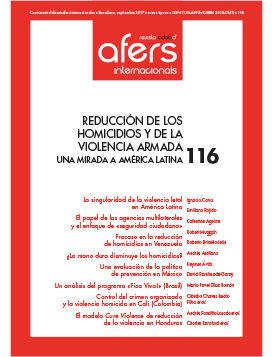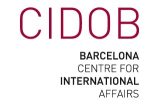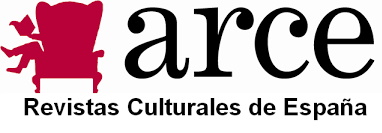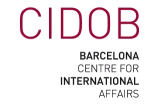Homicide reduction in Minas Gerais: an analysis of the “Fica Vivo!” programme
Keywords:
Brazil, “Fica Vivo!”, prevention programmes, homicides, communityAbstract
Revista CIDOB d’Afers Internacionals, nº 116
Quadrimestral (May-September 2017)
ISSN:1133-6595 | E-ISSN:2013-035X
DOI: https://doi.org/10.24241/rcai.2017.116.2.129
This article presents the results of qualitative research into the “Fica Vivo!” programme’s contribution to the control and reduction of homicides in Minas Gerais (Brazil) in the views of the social and institutional actors involved. The methodology is based on semi-structured interviews and focus groups held with the leaders and monitors of the workshops, and with community leaders and professionals from the public security and penal justice sectors. In these conversations a number of tensions emerged that relate to the social functions of the programme’s actors – the technical team and the public security professionals. Among the disputed issues, particularly noticeable were the perceptions of the programme’s goals and the flow of information between the community and the team in a dynamic that does not always include the Police.
>> The full text articles of this issue are available only in Spanish language
References
Alves, Márcia C. Programas de prevenção da criminalidade: dos processos sociais à inovação da política pública. A experiência do Fica Vivo! Tesis de maestría en Políticas Públicas, Fundação João Pinheiro, 2008.
Alves, Márcia C. y Arias, Enrique Desmond. «Understanding the Fica Vivo programme: two-tiered community policing in Belo Horizonte, Brazil». Policing and Society, vol. 22, n.º 1 (2012), p. 101-113.
Arias, Enrique Desmond y Ungar, Mark. «La Vigilancia Comunitaria y la Crisis de Seguridad Ciudadana en Latinoamérica». Estudios Socio-Jurídicos, vol. 15, n.º 1 (2013), p. 19-52.
Asad, Talal. «Where are the Margins of the State?», en: Das, Veena y Poole, Deborah. Anthropology in the Margins of State. California: SAR Press, 2004, p. 279-288.
Beato, Cláudio C. Case Study «Fico Vivo» Homicide Control Project in Belo Horizonte. Washington, D.C.: World Bank, 2005.
Beato, Cláudio C. Estudio de caso: Programa Fica Vivo en Brasil. Iniciativa centroamericana del sector privado, 2013.
Beato, Cláudio C. y Silveira, Andrea. M. Efetividade e Avaliação em Programas de Prevenção ao Crime em Minas Gerais. Río de Janeiro: Instituto Igarapé, 2014.
Beato, Claudio C. et al. Relatório Final. Projeto referente a Carta de Acordo 33583. Belo Horizonte: Ministério da Justiça, Secretaria Nacional de Segurança Pública (SENASP) y PNUD, 2016.
Braga, Anthony A.; Hureau, David M. y Papachristos, Andrew V. «Deterring Gang-Involved Gun Violence: Measuring the Impact of Boston’s Operation Ceasefire on Street Gang Behavior». Journal of Quantitative Criminology, vol. 30, n.º 1 (2014), p. 113-139.
Burt, Ronald S. «Structural Holes versus Network Closure as Social Capital», en: Lin, Nan; Cook, Karen S. y Burt, Ronald S. (eds.). Social Capital: Theory and Research. Nueva York: Aldine de Gruyter, 2001, p. 31-56.
Cano, Ignacio y Rojido, Emiliano. Mapeo de Programas de Prevención de Homicidios en América Latina y el Caribe. Río de Janeiro: Laboratório de Análise da Violência, 2016.
Castro, Talita Egevardt de. Avaliação de impacto do Programa Fica Vivo! sobre a taxa de homicídios em Minas Gerais. Tesis de maestría en Economía Aplicada, Viçosa: Universidade Federal de Viçosa, 2014.
Das, Veena y Poole, Deborah. Anthropology in the Margins of State. California: SAR Press, 2004.
Feltran, Gabriel de Santis. «Manter a ordem nas periferias de São Paulo: coexistência de dispositivos normativos na “era PCC”», en: Azais, Christian; Kessler, Gabriel y Telles, Vera da Silva (org.). Ilegalismos, cidade e política. Belo Horizonte, MG: Fino Traço, 2012, p. 253-278.
Goldstein, Herman. Problem-Oriented Policing. Filadelfia, PA: Temple University Press, 1990.
Higginson, Angela; Mazerolle, Lorraine; Sydes, Michelle; Davis, Jacqueline y Mengersen, Kerrie. Policing interventions for targeting interpersonal violence in developing countries: a systematic review. 3ie Grantee Final Review. Londres: International Initiative for Impact Evaluation, 2015.
Kennedy, David M. «Pulling levers: Chronic offenders, high-crime settings, and a theory of prevention». Valparaiso Law Review, vol. 31, n.º 2 (1997), p. 449-484.
Lavalle, Adrian Gurza y Büllow, Marisa von. «Sociedade civil e institucionalização da intermediação: Brokers diferentes, dilemas semelhantes». Política & Sociedade, vol. 13, n.º 28 (2014), p. 125-165.
MacDonald, Cathy. «Understanding Participatory Action Research: A Qualitative Research Methodology Option». Canadian Journal of Action Research, vol. 13, n.º 2 (2012), p. 34-50.
Machado da Silva, Luiz A. «Criminalidade Violenta: por uma nova perspectiva de análise». Revista de Sociologia e Política, n.º 13 (1999), p. 115-124.
Marsden, Peter V. «Brokerage Behavior in Restricted Exchange Networks», en: Marsden, Peter V. y Lin, Nan (eds.). Social Structure and Network Analysis. California: Sage, 1982, p. 201-218.
Miller, Lisa Lynn. The politics of community crime prevention: Implementing Operation Weed and Seed in Seattle. Burlington: Ashgate y Dartmouth, 2001.
Peixoto, Betânia. Uma contribuição para a prevenção da violência. Tesis de doctorado em Economía, Cedeplar/UFMG, 2008.
Peixoto, Betânia; Andrade, Monica V. y Azevedo, João P. «Prevention and Control of Homicides: An Evaluation of Impact in Brazil». The Annual Meeting LACEA-LAMES (20-22 de noviembre de 2008), Río de Janeiro, p. 1-20.
Sampson, Robert J. Great American city: Chicago and the enduring neighborhood effect. Illinois: University of Chicago Press, 2012.
Silva, Bráulio Alves F.; Queiroz, Bernardo L.; Marinho, Frederico C.; Caminhas, Diogo A.; Pereira, Fabiano N. A.; Cisalpino, Pedro; Utsh, Bernardo y Gomes, Gabriela. Relatório Final. Projeto Homicídios no Brasil. Belo Horizonte: Ministério da Justiça, Secretaria Nacional de Segurança Pública (SENASP) y PNUD, 2016.
Silveira, Andrea M. Avaliação do programa Fica Vivo no Morro das Pedras em Belo Horizonte. Tesis de doctorado en Ciencias Humanas, Universidade Federal de Minas Gerais, 2007.
Silveira, Andrea M.; Assunção, Renato M.; Silva, Bráulio Alves F. y Beato, Cláudio C. «Impacto do Programa Fica Vivo na redução dos homicídios em comunidade de Belo Horizonte». Revista de Saúde Pública, vol. 44, n.º 3 (2010), p. 496-502.
Stevenson, Lisa. «Anthropology in the Margins of the State (Book review)». PoLAR: Political and Legal Anthropology Review, vol. 30, n.º 1 (2007), p.140-144.
Wilson, William Julius. The truly disadvantaged Chicago. Illinois: University of Chicago, 1987.












